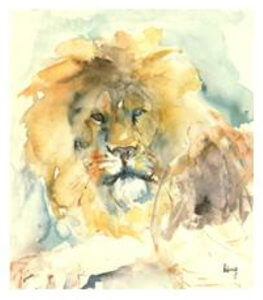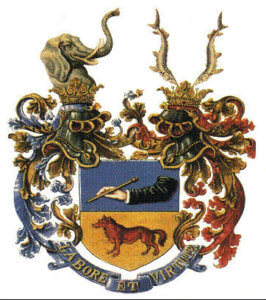a short visit to the zoo of dermatological diagnoses
Karl Holubar MD FRCP
Institute for the History of Medicine University of Vienna
Vienna, Austria
Presented in part at the Meeting of the Croatian Society for the History of Medicine at the Palace of the Croatian Academy of Sciences and Arts, Zagreb, 10th October 2002
author´s address :
Institute for the History of Medicine
University of Vienna
Währinger Strasse 25
A-1090 Vienna, Austria
FAX +43-1-42-77-96-34
KH.histmed@univie.ac.at

The artist has kindly permitted reproduction of her « lion » here.
Skin is a surface which is visible and since old has been an arena of ornation (e.g. tattoos, scars, painting); of punishment and of individuality, to recognize a person, a rank, a caste, a « race » (better « cline »)(1)(2) etc. For instance, the word for caste in Indian society and in the Sanskrit language, varnah, relates to the color of the skin and signifies caste, so to say, the lighter the hue, the « higher » the caste, i.e. the social stance. Classical occidental literature does not differ in this regard e.g. Sappho, stressing that she is not white (Ovidius let her say « candida si non sum », Maximus of Tyros, describes her similarly, « míkra kaì mélaina », small and dark, and Menandros, the Greek playright asks about a sun-tanned person if he were a peasant. Poetry and proverb in Chinese and Japanese offer similar phrases.(3) COLOR is important, or better, absence of it at least in the Northern hemisphere. Négritude, up to our times was the beauty idol of aequatorial latitudes and only later in the 20th century expanded north ! (4)
In a metaphorical sense, and this is referred to by the initial Biblical quotation, the appearance and permanence of skin signs, is used to allude to the characteristics of a personality, a psychological position, a disease, a divine mark.
Second to that, animals, real and mythical (« chimera »), are addressed over the centuries and visibility again is taken for identification before all other sensual cognizance, e.g. hearing (murmurs of the heart or feeble voice e.g. »cri-du-chat » syndrome), smell (goat-like stench), and before behavioural aspects come into play. If animals are referred to, their factual characteristics and/or the legendary features are taken into account in literature, medical and otherwise since the dawn of history. They also became idols, were given divine attributes, were turned into ritual victims in sacrifice, were included in medical jargon, e.g. « zebra ».(5)(6), and, literally, « guinea pig ». Language in general, including many a professsional terminology, has made use of this paradigmata over the millennia. Again, the heading from the Old Testament is a very good example – in a holy text.
Some « animals » not related directly to skin are neglected in the pesent context, e.g. the rabbit in lagophthalmus, the dog in dens caninus, the ox in cor bovinum, the horse in pes equino-varus, the turtle in turtle-neck, the latter being a term à la mode and not medical.
The elephant also related to in elephant man (neurofibromatosis) has been mentioned already. Anyway, no claim is made as to presenting a complete list of animals.
The rich heritage of water colors, moulages and books, largely a bequest from my clinical mother department (Hebra´s clinic) and kept in my medico-historical mother institute, the institute for the history of medicine (Josephinum) in Vienna, as much as a current inter-academy project addressing the iconography in dermatology, let it appear logical and close to heart and mind, to devote enthusiasm to such questions, e.g. animal symbolism in the formation of clinical diagnoses. The following is a short scamper into these areas of philosophy and medical history, dear to any physician´s spiritual world.
Among the monumental atlases of the 19th century, Hebra´s (1856-1876) assumes a central position because of its sheer format, volume and the fame of its physician-artists. (7-10) The first sentence in the first chapter of the first installment in 1856, deals with » Lupus » and reads: « Unsere Vorväter pflegten bösartige und entstellende Hautkrankheiten mit, aus der Tierwelt entnommenen Namen zu belegen » which translates into « our ancestors used to apply names taken from the animal world to malignant and disfiguring diseases of the skin ».(7) Hebra continued this trend and, not surprisingly, the crest given to him when he was knighted in 1878, shows an elephant, two fish, a red wolf and a hand with a pen. (Fig.1) Officially, governmental authorities never explain why certain elements are included in the graphic design of a coat-of-arms, but since the awardee himself has some say in the concept, family tradition well knows about the background: these animals symbolize elephantiasis, ichthyosis, lupus erythematosus and Hebra´s capablities as a medical writer.

(with permission of the family)
The following tabulation lists haphazardly animals as used in dermatological or general medical terminology. Visibility and visual appearance in most cases is the all decisive feature which is relevant for inclusion into our vocabulary.
Tabulation of examples :
- The lion, Gr. leon, leontos, lion – facies leontina
- The elephant – elephantiasis
- The fox, Gr. alopex – alopecia
- The snake, Gr. ophis – ophiasis
- The snake again:Gr. herpo, crawl – herpes
- The fish, Gr. ichthys – ichthyosis
- The goose, Lat. anser – cutis anserina
- The male goat, Lat. hircus – axillary sweat, plural:hirci: axillary hair
- The porcupine, Gr. hystrix – ichthyosis hystrix
- The crab, Gr. kankros – cancer
- The fly, Gr. myia – myiasis
- The moth, Lat. tinea – mycoses
- The ant, Lat. formica – Lupus formicans
- The worm, Lat. vermis – cutis vermicularis
- Tierfell-Naevus, Germ. Tier, animal, extensive hairy naevus
- Storchen-Biss, Germ. Storch, stork,- naevus flammeus in the nuchal and frontal regions
- The buffalo – buffalo hump
Moreover there are
- Leopard cats, -frogs, -sharks. –lizards, -seals, -moths, -and
- Tiger-spiders
Suffice it to say that ther is more beyond the above.
- (i) no claim is made that a « all » animals, mythical or real, have been listed
- (ii) that all spects of such animals have been alluded to.
Cheetah, leopard and jaguar, lion of course and tiger, all are felidae but do express very different characteristics just what the pigmentation of the surface is concerned (including albino variants).
Young lions have no uniform colour; tails of some felidae may be spotted or have stripes; jaguars in fact have « rosettes », not spots on their furs with alternating degress of pigmentation from center to periphery – and they may be black, as much as old world « panthers ». Even semantics are a problem, Jeremiah´s word, – archaic Hebrew as it is, – « khabarburah » means stripe rather than spot. And to complete the confusion language presents us with, we have tiger-spiders (all too many in Central Europe after this year´s floods), and leopard-cats, leopard-frogs, -sharks, -seals, -lizards, -moths.
The two expressions taken from the German language medical parlance need a word of explanation. (i) Large, hairy nevi are compared to animal furs (Tier-fell) and called such. (ii)The saying, in folk-legends, that storks carry the newborn babies into the world by holding their heads in their beaks, touching the glabella and the nuchal areas, sometime leaving marks: the « bite » of a stork, in German Storchen-biss for this preferential localization of nevi flammei.
Some of the above animal-allusions have become integrated into the everyday vocabulary of dematologists, e.g. tinea, alopecia, ichthyosis, others are hardly remembered as to their origin, say, cutis anserina or myiasis and hircus. Lupus, without any doubt has received the broadest acceptance and the strongest sense of metaphorical interpretation, even has reached a twofold specific association. (i) as L. vulgaris, a form of secondary tuberculosis of the skin, which affected millions in the urban centers of Europe and (ii) as Lupus erythematosus, colloquially referred to as L.E. a chronic inflammatory disease of the connecdtive tissue of autoimmune pathogenesis. The former was originally described by Robert Willan (1757-1812) (12) the later by Pierre-Louis-Alphée Cazenave (1795-1877) in 1850 (11)(12). The term « lupus » without specification was traced to Giovanni Manardi (1462-1536) of Ferrara and the year 1500 by Hebra himself in the context described above. (7). Age old phantasies of the wild nature and ripping-off bites of this canine animal echo through the centuries when « lupus » is mentioned for destructive processes of all sorts. Suffice it to remember that « lýkos, λύκος » is the Greek word for wolf, « vrikah » in Sanskrit (vŗik, varkate, vŗíkah), « vlk, vuk » in the Slavonic idioms, all offering some onomatopoetic similarities to the modern English and German words. The term facies leontina, lion-face, in lepromatous leprosy is hardly less fearsome and well known, and the same holds for elephantiasis. The remainder of the « animals » hide quietly behind he semantic ignorance of most doctors of today. For the medico-historian however they populate the terminological world of medicine and keep it flowery.
We do have a zoo indeed, in the real world, in our myths and legends, in various disciplines´ terminologies and, – skin being so overt and obvious, – in dermatology which is involved preferentially for this very reason. It is worth being aware of the terminological richesse in our patrimony and its semantic origins notwithstanding the unfortunate prospect that some of these species may soon become extinct (if not already so). Next to eponyms (11) such figurative allusions enrich our vision of disease and may help understand patients, aware or not of a specific term, but full of pain and shame and fear because of obvious sickness and embarassed because of the spectacle we stage at times, at their expense, when we present « zebras ».(5)(6)
Références
| (1) | Holubar,K.: What is a Caucasian? J.Invest.Dermatol. 106: 4, 800 (1996) |
| (2) |
Holubar, K.: Races, Clines, and Phototypes. |
| (3) |
Holubar,K.: Black Skin and the Ideal of Beauty. |
| (4) |
Holubar K: A Hail to the Chief. |
| (5) |
Biro D: Reflections of a Zebra? |
| (6) |
Biro D: One hundred deays. |
| (7) |
Hebra F: Atlas der Hautkrankheiten. Austrian Ac Sci (k.k.Österr. Akademie der Wissenschaften), Vienna, 1856, |
| (8) |
Fatović-Ferenčić S Holubar K: Dermatomycosis: Founders and Illustrators |
| (9) |
Holubar K Fatović-Ferenčić S: Iconography in Dermatology. Editorial |
| (10) |
Fatović-Ferenčić S Holubar K: Cutaneous Infections and Infestations in Historical (Iconographic) Perspective. |
| (11) | Crissey JT Parish LC Holubar K:Historical Atlas of Dermatology and Dermatologists. Parthenon, London 2002 |
| (12) |
Fatović-Ferenčić S Holubar K: History of lupus erythematosus. Clinics in Dermatology (in press) |
